Improving the Estimation of Forest Carbon Density in Mountainous Regions Using Topographic Correction and Landsat 8 Images
Abstract
1. Introduction
2. Data and Methods
2.1. Study Area
2.2. Data
2.2.1. Field Measured Data
2.2.2. Remote Sensing Data
2.2.3. Digital Elevation Model (DEM)
2.3. Traditional Topographic Correction (TC) Methods
2.4. Topographic Correction Considering Local Parameter Estimation
2.5. Estimation of Forest Carbon Density
3. Results
3.1. Comparison of TC Models Considering LPE with Different Window Sizes
3.1.1. Correlation Analysis
3.1.2. Stability of Land Covers
3.1.3. Comparison of Reflectance between Sunlit and Shaded Slopes
3.1.4. Accuracy Assessment of Forest Carbon Density
3.2. Comparison between Traditional TC Models and LPE-TC Models
3.2.1. Visual Analysis
3.2.2. Correlation Analysis
3.2.3. Stability of Land Covers
3.2.4. Comparison of Reflectance between Sunlit and Shaded Slopes
3.2.5. Accuracy Assessment of Forest Carbon Density
3.3. Estimation of Forest Carbon Density
3.3.1. Statistics of Sample Plots
3.3.2. Correlation Analysis
3.3.3. Accuracy Assessment
3.3.4. Spatial Analysis
4. Discussion
4.1. Comparison of TC Models Considering LPE with Different Kernel Sizes
4.2. Comparison between Traditional TC Models and TC Models Considering LPE
4.3. Estimation of Forest Carbon Density
4.4. Computation Load for the Framework Considering LPE
5. Conclusions
Author Contributions
Funding
Acknowledgments
Conflicts of Interest
References
- Schimel, D.; House, J.; Hibbard, K.; Bousquet, P.; Ciais, P.; Peylin, P.; Braswell, B.H.; Apps, M.J.; Baker, D.; Bondeau, A.; et al. Recent patterns and mechanisms of carbon exchange by terrestrial ecosystems. Nature 2001, 414, 169–172. [Google Scholar] [CrossRef] [PubMed]
- Yan, E.; Lin, H.; Wang, G.; Sun, H. Improvement of forest carbon estimation by integration of regression models and spectral unmixing of Landsat data. IEEE Geosci. Remote Sens. Lett. 2015, 12, 2003–2007. [Google Scholar]
- Yan, E.; Lin, H.; Wang, G.; Sun, H. Multi-resolution mapping and accuracy assessment of forest carbon density by combining image and plot data from a nested and clustering sampling design. Remote Sens. 2016, 8, 571. [Google Scholar] [CrossRef]
- Nabuurs, G.; Putten, B.; Knippers, T.; Mohren, G. Comparison of uncertainties in carbon sequestration estimates for a tropical and a temperate forest. For. Ecol. Manag. 2008, 256, 237–245. [Google Scholar] [CrossRef]
- Luo, K.S. Spatial pattern of forest carbon storage in the vertical and horizontal directions based on HJ-CCD remote sensing imagery. Remote Sens. 2019, 11, 788. [Google Scholar] [CrossRef]
- Kim, S.; Lee, W.; Kwak, D.; Biging, G.; Gong, P.; Lee, J.; Cho, H. Forest cover classification by optimal segmentation of high-resolution satellite imagery. Sensors 2011, 11, 1943–1958. [Google Scholar] [CrossRef]
- Zhang, Z.; Kazakova, A.; Moskal, L.; Styers, D. Object-based tree species classification in urban ecosystems using LiDAR and hyperspectral data. Forests 2016, 7, 122. [Google Scholar] [CrossRef]
- Tian, S.; Zhang, X.; Tian, J.; Sun, Q. Random forest classification of wetland land covers from multi-sensor data in the arid region of Xinjiang, China. Remote Sens. 2017, 8, 954. [Google Scholar] [CrossRef]
- Hughes, R.; Asner, G.; Baldwin, J.; Mascaro, J.; Bufil, L.; Knapp, D. Estimating aboveground carbon density across forest landscapes of Hawaii: Combining FIA plot-derived estimates and airborne LiDAR. For. Ecol. Manag. 2018, 424, 323–337. [Google Scholar] [CrossRef]
- Berninger, A.; Lohberger, S.; Stängel, M.; Siegert, F. SAR-based estimation of above-ground biomass and its changes in tropical forests of Kalimantan using L- and C-band. Remote Sens. 2018, 10, 831. [Google Scholar] [CrossRef]
- Hirata, Y.; Furuya, N.; Saito, H.; Pak, C.; Leng, C.; Sokh, H.; Ma, V.; Kajisa, T.; Ota, T.; Mizoue, N. Object-based mapping of aboveground biomass in tropical forests using LiDAR and very-high-spatial-resolution satellite data. Remote Sens. 2018, 10, 438. [Google Scholar] [CrossRef]
- Li, Y.; Han, N.; Li, X.; Du, H.; Mao, F.; Cui, L.; Liu, T.; Xing, L. Spatiotemporal estimation of bamboo forest aboveground carbon storage based on Landsat data in Zhejiang, China. Remote Sens. 2018, 10, 898. [Google Scholar] [CrossRef]
- Zhu, J.; Huang, Z.; Hua, S.; Wang, G. Mapping forest ecosystem biomass density for Xiangjiang River Basin by combining plot and remote sensing data and comparing spatial extrapolation methods. Remote Sens. 2017, 9, 241. [Google Scholar] [CrossRef]
- Fan, W.; Li, J.; Liu, Q.; Zhang, Q.; Yin, G.; Li, A.; Zeng, Y.; Xu, B.; Xu, X.; Zhou, G.; et al. Topographic correction of forest image data based on the canopy reflectance model for sloping terrains in multiple forward mode. Remote Sens. 2018, 10, 717. [Google Scholar] [CrossRef]
- Lars, E.S. Topographic effects in Geoid determinations. Geosciences 2018, 8, 143. [Google Scholar] [CrossRef]
- Melnikova, M.; Awaya, Y.; Saitoh, T.M.; Muraoka, H.; Sasai, T. Estimation of leaf area index in a mountain forest of central Japan with a 30-m spatial resolution based on Landsat operational Land imager imagery: An application of a simple model for seasonal monitoring. Remote Sens. 2018, 10, 179. [Google Scholar] [CrossRef]
- Zhang, Z.; He, J.; Liu, D.; Wang, X.; Jiang, H. An improved physical model to correct topographic effects in remotely sensed imagery. Spectrosc. Spectr. Anal. 2010, 30, 1839–1842. [Google Scholar]
- Duan, S.; Shi, K.; Lu, Z. Research on topographic correction of remotely sensed image in rugged terrain areas based on SRTM3. Sci. Technol. Eng. 2012, 12, 8147–8153. [Google Scholar]
- Wang, S.; Li, X.; Zhang, Q.; Chen, X.; Ye, W. Analysis on the applicability of the topographic correction models for Landsat images. J. Huazhong Norm. Univ. 2013, 47, 571–577. [Google Scholar]
- Li, A.; Wang, Q.; Bian, J.; Lei, G. An improved physics-based model for topographic correction of Landsat TM images. Remote Sens. 2015, 7, 6296–6319. [Google Scholar] [CrossRef]
- Ediriweera, S.; Pathirana, S.; Danaher, T.; Nichols, D.; Moffiet, T. Evaluation of different topographic corrections for Landsat TM data by Prediction of Foliage Projective Cover (FPC) in topographically complex landscapes. Remote Sens. 2013, 5, 6767–6789. [Google Scholar] [CrossRef]
- Balthazar, V.; Vanacker, V.; Lambin, E. Evaluation and parameterization of ATCOR3 topographic correction method for forest cover mapping in mountain areas. Int. J. Appl. Earth Obs. Geoinf. 2012, 18, 436–450. [Google Scholar] [CrossRef]
- Zhang, W.; Gao, Y. Topographic correction algorithm for remotely sensed data accounting for indirect irradiance. Int. J. Remote Sens. 2011, 32, 1807–1824. [Google Scholar] [CrossRef]
- Couturier, S.; Gastellu-Etchegorry, J.; Martin, E.; Patiño, P. Building a forward-mode three-dimensional reflectance model for topographic normalization of high-resolution (1–5 m) imagery: Validation phase in a forested environment. IEEE Trans. Geosci. Remote Sens. 2013, 51, 3910–3921. [Google Scholar] [CrossRef]
- Richter, R.; Kellenberger, T.; Kaufmann, H. Comparison of topographic correction methods. Remote Sens. 2009, 1, 184–196. [Google Scholar] [CrossRef]
- Gao, Y.; Zhang, W. A simple empirical topographic correction method for ETM+ imagery. Int. J. Remote Sens. 2009, 30, 2259–2275. [Google Scholar] [CrossRef]
- Blesius, L.; Weirich, F. The use of the Minnaert correction for land-cover classification in mountainous terrain. Int. J. Remote Sens. 2005, 26, 3831–3851. [Google Scholar] [CrossRef]
- Li, H.; Xu, L.; Shen, H.; Zhang, L. A general variational framework considering cast shadows for the topographic correction of remote sensing imagery. ISPRS J. Photogramm. Remote Sens. 2016, 117, 161–171. [Google Scholar] [CrossRef]
- Reese, H.; Olsson, H. C-correction of optical satellite data over alpine vegetation areas: A comparison of sampling strategies for determining the empirical c-parameter. Remote Sens. Environ. 2011, 115, 1387–1400. [Google Scholar] [CrossRef]
- Soenen, S.; Peddle, D.; Coburn, C. SCS+C: A modified sun-canopy-sensor topographic correction in forested terrain. IEEE Trans. Geosci. Remote Sens. 2005, 43, 2148–2159. [Google Scholar] [CrossRef]
- Hantson, S.; Chuvieco, E. Evaluation of different topographic correction methods for Landsat imagery. Int. J. Appl. Earth Obs. Geoinf. 2011, 13, 691–700. [Google Scholar] [CrossRef]
- Sola, I.; María, G.; Jesús, Á. The added value of stratified topographic correction of multispectral images. Remote Sens. 2016, 8, 131. [Google Scholar] [CrossRef]
- Huang, B.; Xu, L. Applied research of Topographic correction based on the improved Minnaert model. Remote Sens. Technol. Appl. 2013, 27, 183–189. (In Chinese) [Google Scholar]
- Uday, P.; Asamaporn, S.; Dario, S.; Sukan, P.; Kumron, L.; Amnat, C. Topographic correction of Landsat TM-5 and Landsat OLI-8 imagery to improve the performance of forest classification in the mountainous terrain of Northeast Thailand. Sustainability 2017, 9, 258. [Google Scholar]
- Vázquez-Jiménez, R.; Romero-Calcerrada, R.; Ramos-Bernal, R.N.; Arrogante-Funes, P.; Novillo, C.J. Topographic correction to Landsat imagery through slope classification by applying the SCS+C Method in mountainous forest areas. ISPRS Int. J. Geo-Inf. 2017, 6, 287. [Google Scholar] [CrossRef]
- Tan, B.; Wolfe, R.E.; Masek, J.; Gao, F.; Vermote, E. An illumination correction algorithm on Landsat-TM data. In Proceedings of the IEEE International Geoscience & Remote Sensing Symposium, IGARSS 2010, Honolulu, HI, USA, 25–30 July 2010; pp. 1964–1967. [Google Scholar]
- Yu, Z.; Zhang, C.; Chen, J.; He, C. Topographic correction of sunny and shady slope in different division methods based on slope-matching model. J. Southwest For. Univ. 2017, 37, 178–187. [Google Scholar]
- Sola, I.; María, G.; Jesús, Á. Multi-criteria evaluation of topographic correction methods. Remote Sens. Environ. 2016, 8, 247–262. [Google Scholar] [CrossRef]
- Riaño, D.; Chuvieco, E.; Salas, J.; Aguado, I. Assessment of different topographic corrections in Landsat-TM data for mapping vegetation types. IEEE Trans. Geosci. Remote Sens. 2003, 41, 1056–1061. [Google Scholar] [CrossRef]
- Gao, M.; Zhao, W.; Gong, Z.; Chen, Z.; Tang, X. Topographic correction of ZY-3 satellite images and its effects on estimation of shrub leaf biomass in mountainous areas. Remote Sens. 2014, 6, 3141–3151. [Google Scholar] [CrossRef]
- Lu, D.; Ge, H.; He, S.; Xu, A.; Zhou, G.; Du, H. Pixel-based Minnaert correction method for reducing topographic effects on a Landsat 7 ETM+ image. Photogramm Eng. Remote Sens. 2008, 74, 1343–1350. [Google Scholar]
- Szantoi, Z.; Simonetti, D. Fast and robust topographic correction method for medium resolution satellite imagery using a stratified approach. IEEE J. Sel. Top. Appl. Earth Obs. Remote Sens. 2013, 6, 1921–1933. [Google Scholar] [CrossRef]
- Mo, D.; Fuchs, H.; Fehrmann, L.; Yang, H.; Lu, Y.; Kleinn, C. Local parameter estimation of topographic normalization for forest type classification. IEEE Geosci. Remote Sens. Lett. 2015, 12, 1998–2002. [Google Scholar]
- Xiao, R.; Jiang, D.; Christakos, G.; Fei, X.; Wu, J. Soil Landscape pattern changes in response to rural anthropogenic activity across Tiaoxi Watershed, China. PLoS ONE 2016, 11, e0166224. [Google Scholar] [CrossRef] [PubMed]
- Li, H.; Lei, Y. Estimation and Evaluation of Forest Biomass Carbon Storage in China; China Forestry Press: Beijing, China, 2010. (In Chinese) [Google Scholar]
- Fan, W.; Zhang, H.; Yu, Y.; Mao, X.; Yang, J. Comparison of three models of forest biomass estimation. Chin. J. Appl. Ecol. 2011, 35, 402–410. (In Chinese) [Google Scholar] [CrossRef]
- Wu, Q.; Jin, Y.; Fan, H. Evaluating and comparing performances of topographic correction methods based on multi-source DEMs and Landsat-8 OLI Data. Int. J. Remote Sens. 2016, 37, 4712–4730. [Google Scholar] [CrossRef]
- Adhikari, H.; Heiskanen, J.; Maeda, E.; Pellikka, P. The effect of topographic normalization on fractional tree cover mapping in tropical mountains: An assessment based on seasonal Landsat time series. Int. J. Appl. Earth Obs. Geoinf. 2016, 52, 20–31. [Google Scholar] [CrossRef]
- Fan, Y.; Koukal, T.; Weisberg, P. A sun–crown–sensor model and adapted C-correction logic for topographic correction of high-resolution forest imagery. ISPRS J. Photogramm. Remote Sens. 2014, 96, 94–105. [Google Scholar] [CrossRef]
- Ghasemi, N.; Mohammadzadeh, A.; Reza, S. Assessment of different topographic correction methods in ALOS AVNIR-2 data over a forest area. Int. J. Digit. Earth 2011, 6, 1–17. [Google Scholar] [CrossRef]
- Moreira, E.; Valeriano, M. Application and evaluation of topographic correction methods to improve land cover mapping using object-based classification. Int. J. Appl. Earth Obs. Geoinf. 2014, 32, 208–217. [Google Scholar] [CrossRef]
- Xie, H.; An, D.; Chen, L.; Huang, X.; Zhou, Z. Effect of flat surface assumption on time-domain imaging of rolling terrain for one-stationary bistatic UWB SAR. In Proceedings of the 2013 14th International Radar Symposium (IRS), Dresden, Germany, 19–21 June 2013; pp. 485–490. [Google Scholar]
- Goslee, S.C. Analyzing remote sensing data in R: The Landsat Package. J. Stat. Softw. 2011, 43, 668–672. [Google Scholar] [CrossRef]
- Shepherd, J.; Dymond, J.; Gillingham, S.; Bunting, P. Accurate registration of optical satellite imagery with elevation models for topographic correction. Remote Sens. Lett. 2014, 5, 637–641. [Google Scholar] [CrossRef]
- Schulmann, T.; Katurji, M.; Zawar-Reza, P. Seeing through shadow: Modelling surface irradiance for topographic correction of Landsat ETM+ data. ISPRS J. Photogramm. Remote Sens. 2015, 99, 14–24. [Google Scholar] [CrossRef]
- Tokola, T.; Sarkeala, J.; Vander Linden, M. Use of topographic correction in Landsat TM based forest interpretation in Nepal. Int. J. Remote Sens. 2001, 22, 551–563. [Google Scholar] [CrossRef]
- Park, S.; Im, J.; Park, S.; Yoo, C.; Han, H.; Rhee, J. Classification and mapping of paddy rice by combining Landsat and SAR time series data. Remote Sens. 2018, 10, 447. [Google Scholar] [CrossRef]
- Wu, J.; Liu, H.; Wei, G.; Song, T.; Zhang, C.; Zhou, H. Flash Flood Forecasting Using Support Vector Regression Model in a Small Mountainous Catchment. Water 2019, 11, 1327. [Google Scholar] [CrossRef]
- Deo, R.C.; Sahin, M. Forecasting long-term global solar radiation with an ANN algorithm coupled with satellite-derived (MODIS) land surface temperature (LST) for regional locations in Queensland. Renew. Sustain. Energy Rev. 2017, 72, 828–848. [Google Scholar] [CrossRef]
- Kuhnlein, M.; Appelhans, T.; Thies, B.; Nauss, T. Improving the accuracy of rainfall rates from optical satellite sensors with machine learning—A random forests-based approach applied to MSG SEVIRI. Remote Sens. Environ. 2014, 141, 129–143. [Google Scholar] [CrossRef]
- Yeom, J.; Park, S.; Chae, T.; Kim, J.; Lee, C.S. Spatial assessment of solar radiation by machine learning and deep neural network models using data provided by the COMS MI geostationary satellite: A case study in South Korea. Sensors 2019, 19, 2082. [Google Scholar] [CrossRef]
- Jang, E.; Im, J.; Park, G.H.; Park, Y.G. Estimation of fugacity of carbon dioxide in the East Sea using in situ measurements and Geostationary Ocean Color Imager satellite data. Remote Sens. 2017, 9, 821. [Google Scholar] [CrossRef]
- MathWorks. Available online: http://mathworks.com/help/stats/fitsvm.html (accessed on 1 May 2019).
- Hoshikawa, K.; Umezaki, M. Effects of terrain-induced shade removal using global DEM data sets on land-cover classification. Int. J. Remote Sens. 2014, 35, 1331–1355. [Google Scholar] [CrossRef]
- Wang, G.; Gertner, G.; Anderson, A. Spatial variability based algorithms for scaling up spatial data and uncertainties. IEEE Trans. Geosci. Remote Sens. 2004, 42, 2004–2015. [Google Scholar] [CrossRef]
- Wang, G.; Gertner, G.; Anderson, A.; Howard, H. Repeated measurements on permanent plots using local variability sampling for monitoring soil cover. Catena 2008, 73, 75–88. [Google Scholar] [CrossRef]
- Wang, G.; Oyana, T.; Zhang, M.; Adu-Prah, S.; Zeng, S.; Lin, H.; She, J. Mapping and spatial uncertainty analysis of forest vegetation carbon by combining national forest inventory data and satellite images. For. Ecol. Manag. 2009, 258, 1275–1283. [Google Scholar] [CrossRef]
- Fu, D.; Chen, B.; Zhang, H.; Wang, J.; Black, A.; Amiro, B.D. Estimating landscape net ecosystem exchange at high spatial–temporal resolution based on Landsat data, an improved upscaling model framework, and eddy covariance flux measurements. Remote Sens. Environ. 2014, 141, 90–104. [Google Scholar] [CrossRef]
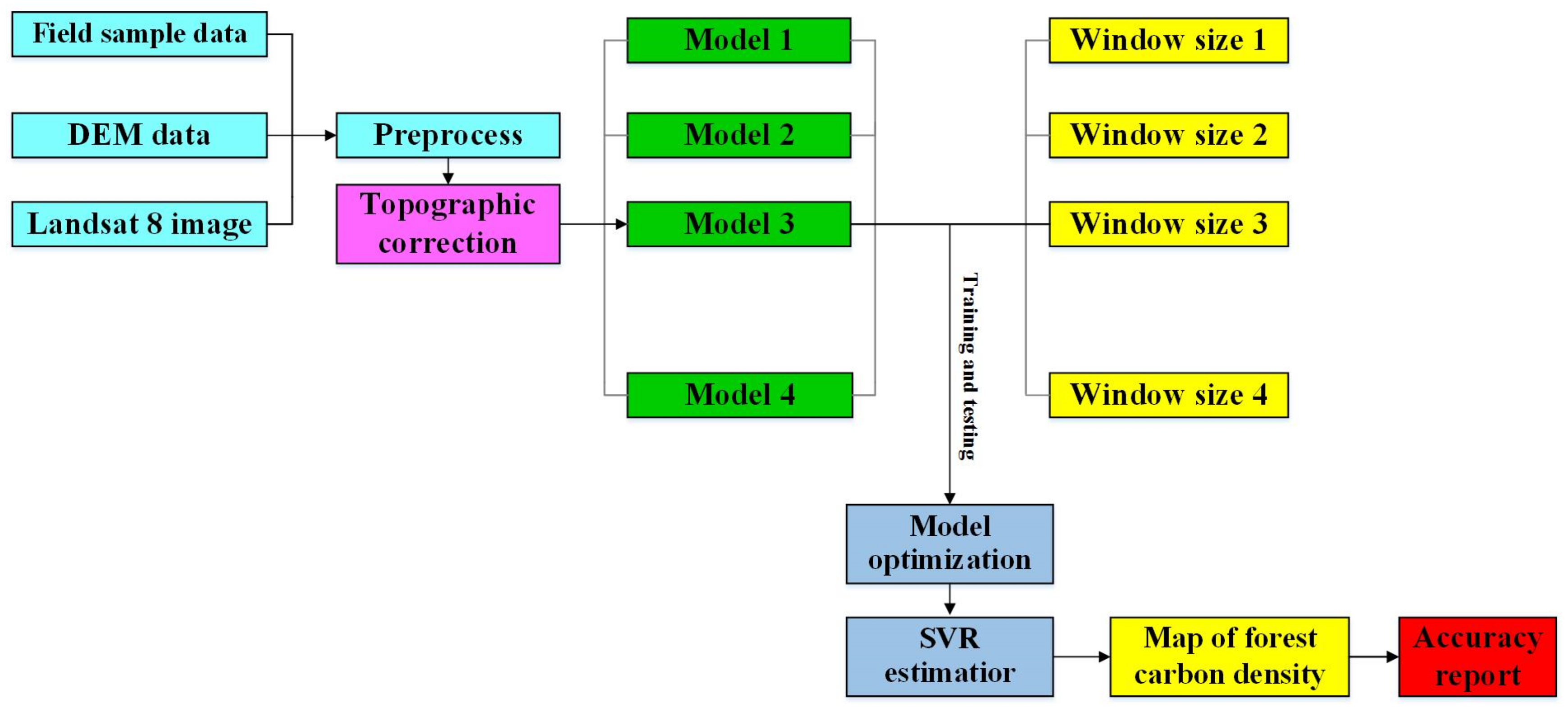
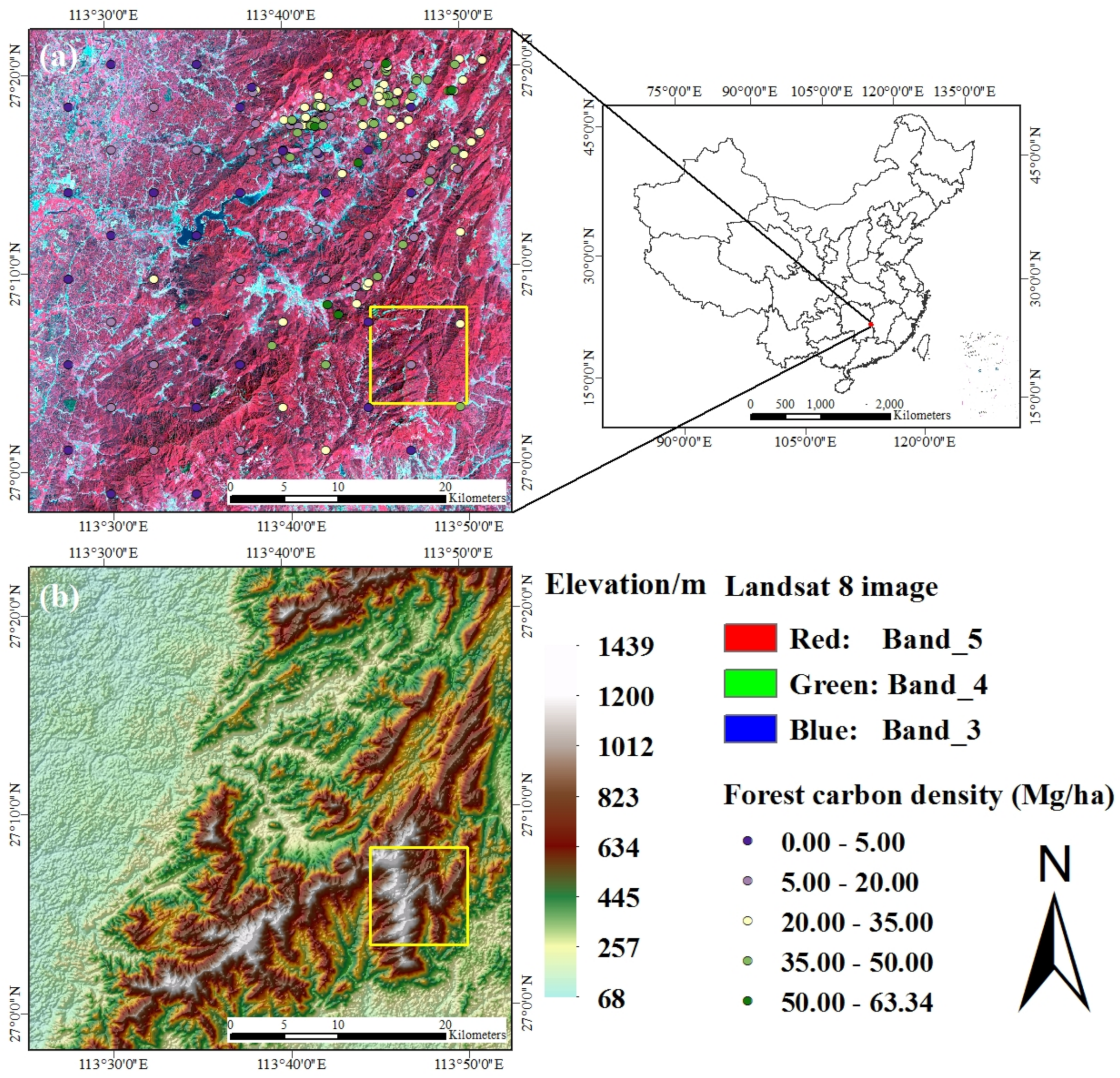
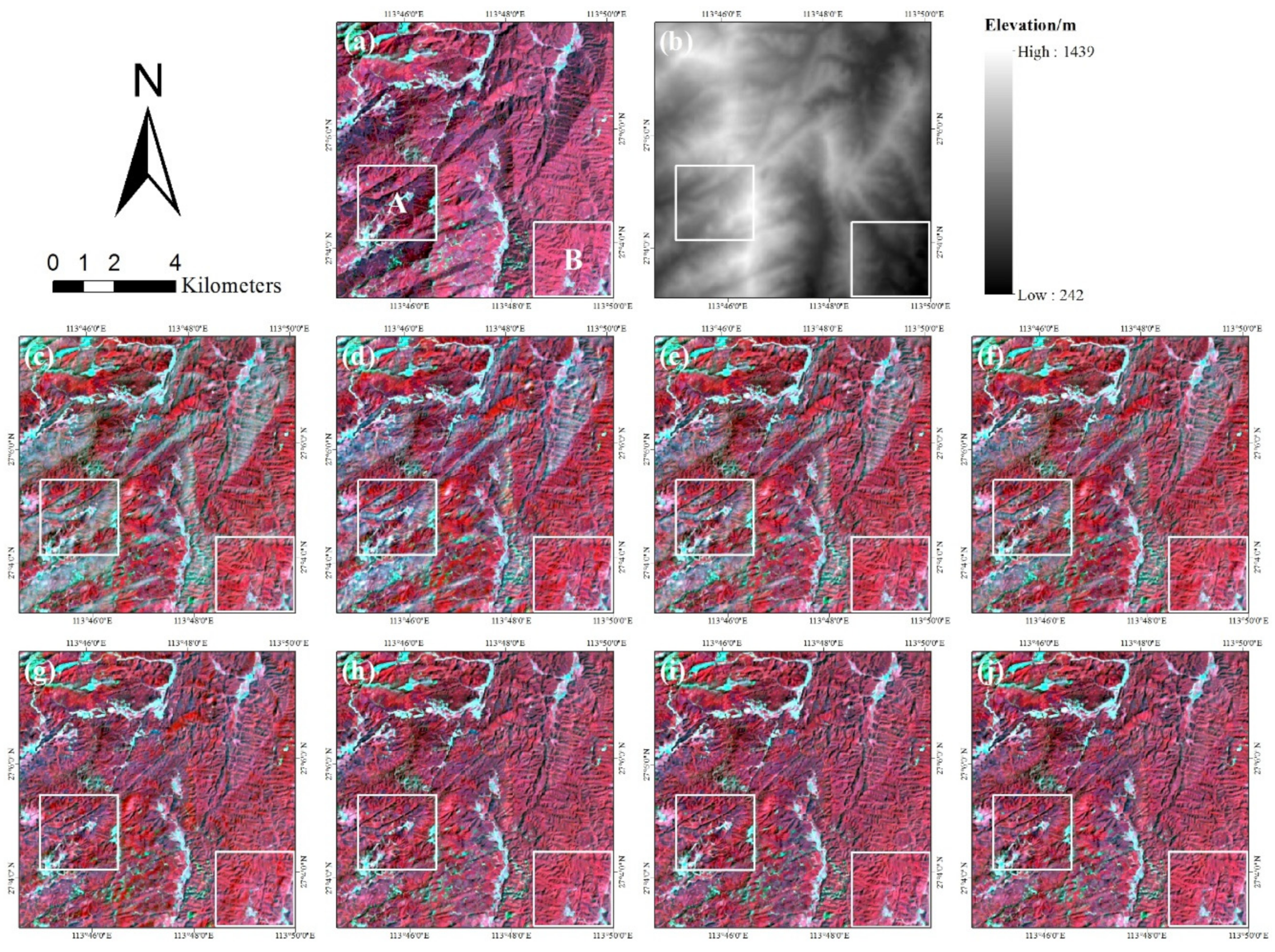
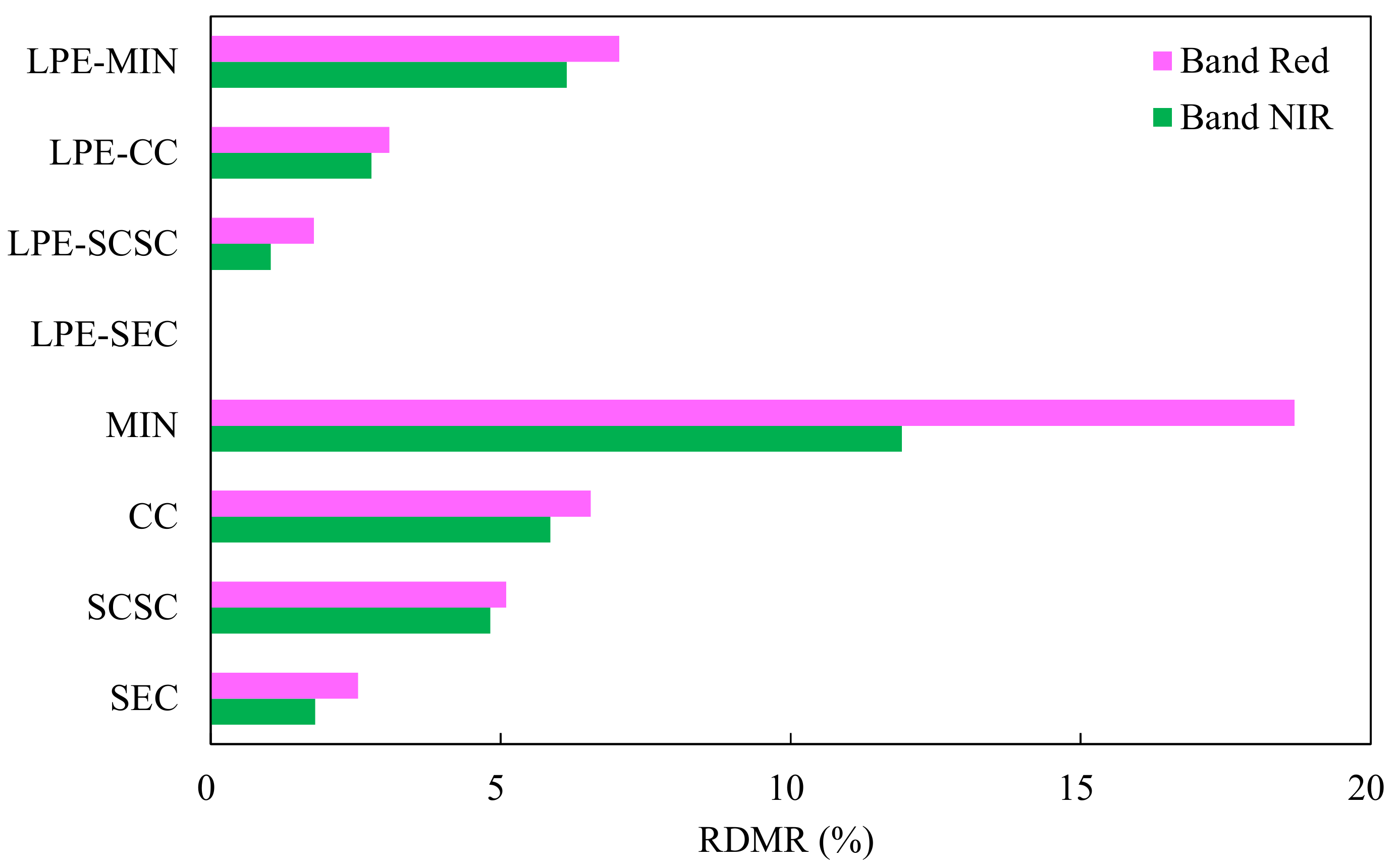
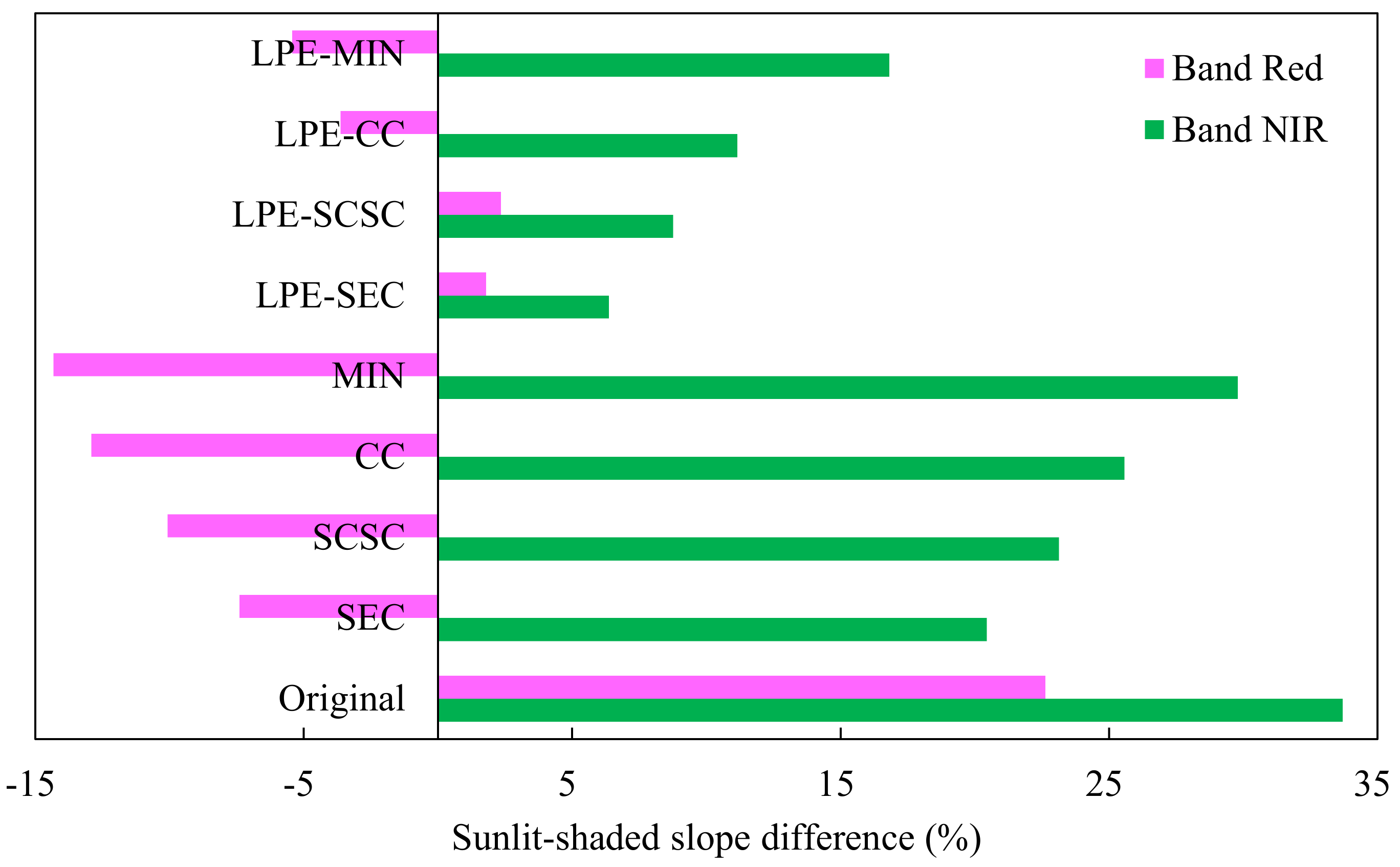
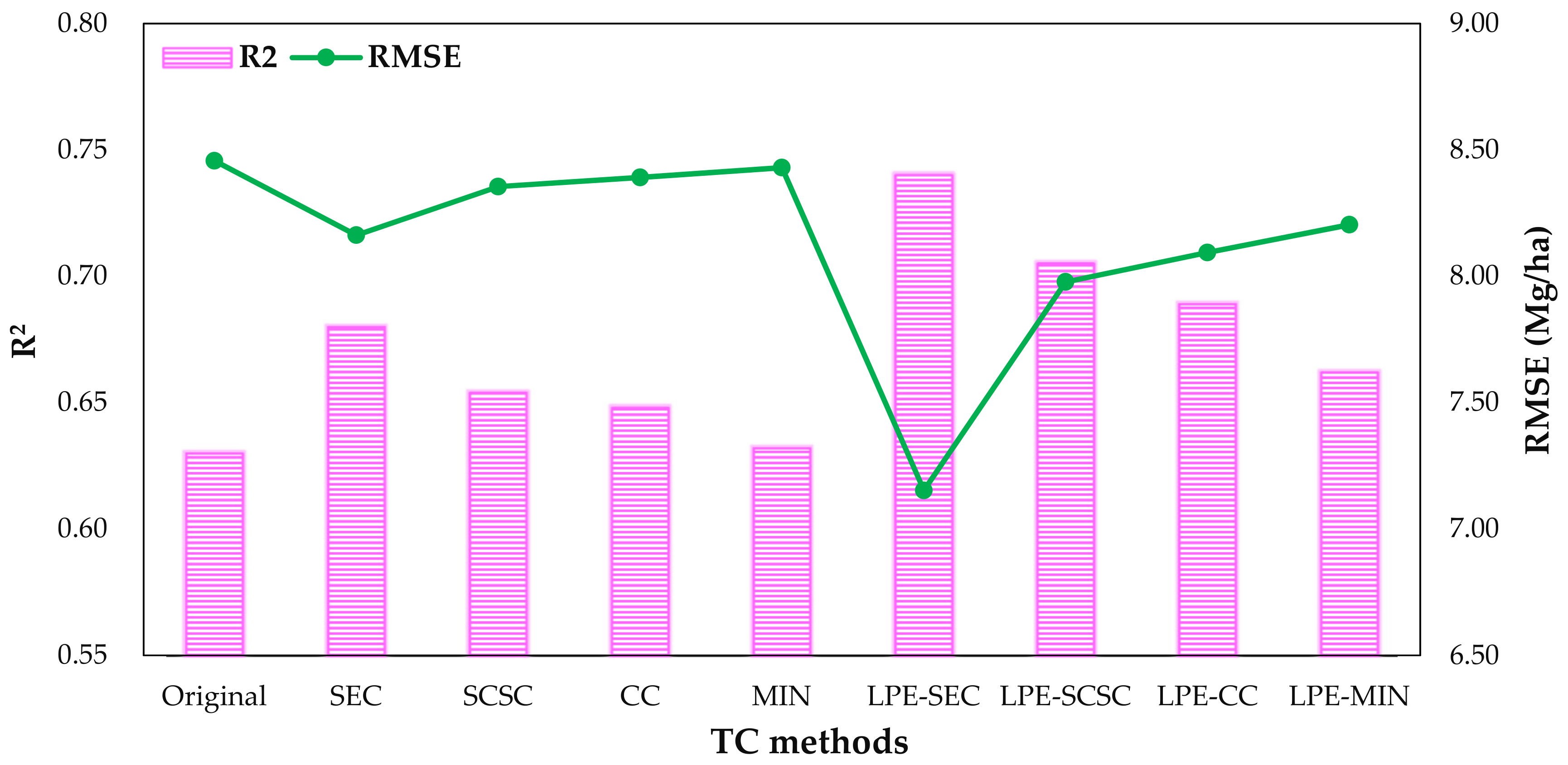
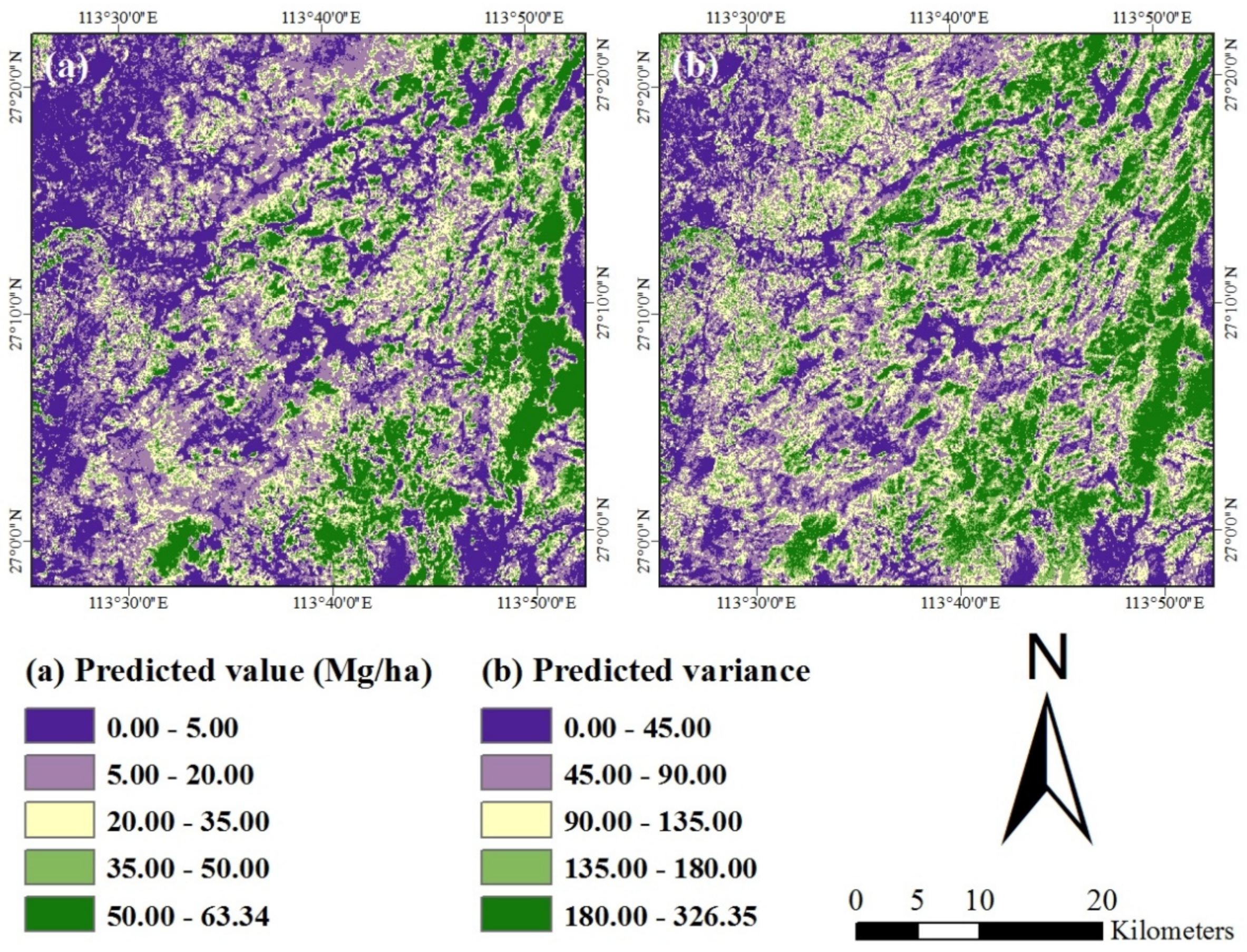
| Methods | LPE-MIN | LPE-CC | LPE-SCSC | LPE-SEC | |||||
|---|---|---|---|---|---|---|---|---|---|
| Kernel Size (Pixels) | Red | NIR | Red | NIR | Red | NIR | Red | NIR | |
| 15 | 0.0046 | 0.0015 | 0.0021 | 0.0042 | 0.0015 | 0.0011 | 0.0012 | 0.0006 | |
| 25 | 0.0035 | 0.0010 | 0.0015 | 0.0025 | 0.0012 | 0.0005 | 0.0008 | 0.0004 | |
| 50 | 0.0021 | 0.0005 | 0.0010 | 0.0017 | 0.0001 | 0.0002 | 0.0001 | 0.0002 | |
| 100 | 0.0020 | 0.0003 | 0.0013 | 0.0029 | 0.0005 | 0.0003 | 0.0000 | 0.0001 | |
| 250 | 0.0089 | 0.0021 | 0.0089 | 0.0043 | 0.0026 | 0.0009 | 0.0015 | 0.0008 | |
| 500 | 0.0154 | 0.0065 | 0.0189 | 0.0054 | 0.0068 | 0.0016 | 0.0026 | 0.0010 | |
| 1000 | 0.0268 | 0.0118 | 0.0341 | 0.0065 | 0.0092 | 0.0028 | 0.0048 | 0.0012 | |
| Methods | LPE-MIN (%) | LPE-CC (%) | LPE-SCSC (%) | LPE-SEC (%) | |||||
|---|---|---|---|---|---|---|---|---|---|
| Kernel Size (Pixels) | Red | NIR | Red | NIR | Red | NIR | Red | NIR | |
| 15 | 10.204 | 8.426 | 5.039 | 3.438 | 2.918 | 2.330 | 0.769 | 0.473 | |
| 25 | 8.245 | 7.144 | 3.986 | 2.908 | 2.517 | 1.680 | 0.158 | 0.121 | |
| 50 | 7.360 | 6.374 | 3.081 | 2.774 | 1.779 | 1.039 | 0.043 | 0.031 | |
| 100 | 7.045 | 6.142 | 3.341 | 2.939 | 2.019 | 1.251 | 0.016 | 0.010 | |
| 250 | 9.634 | 8.050 | 4.634 | 3.650 | 3.421 | 2.981 | 0.262 | 0.385 | |
| 500 | 11.569 | 9.682 | 5.667 | 4.210 | 3.857 | 3.374 | 1.364 | 0.877 | |
| 1000 | 14.857 | 10.989 | 6.394 | 4.837 | 4.438 | 3.733 | 2.033 | 1.481 | |
| Methods | LPE-MIN (%) | LPE-CC (%) | LPE-SCSC (%) | LPE-SEC (%) | |||||
|---|---|---|---|---|---|---|---|---|---|
| Kernel Sizes (Pixels) | Red | NIR | Red | NIR | Red | NIR | Red | NIR | |
| 15 | −10.694 | 23.360 | −8.518 | 17.539 | −5.060 | 15.283 | −4.761 | 13.346 | |
| 25 | −8.766 | 20.029 | −5.405 | 14.956 | −3.096 | 11.367 | −3.060 | 9.097 | |
| 50 | −8.287 | 18.715 | −3.628 | 11.758 | 2.351 | 8.153 | −2.114 | 8.004 | |
| 100 | −7.430 | 17.816 | −4.548 | 12.496 | −2.892 | 9.623 | 1.796 | 6.368 | |
| 250 | −9.657 | 21.494 | −6.657 | 15.494 | −4.179 | 13.416 | −3.388 | 11.441 | |
| 500 | −11.582 | 25.518 | −9.567 | 19.760 | −6.759 | 17.590 | −5.026 | 16.574 | |
| 1000 | −13.745 | 27.403 | −11.499 | 22.648 | −8.125 | 20.353 | −6.487 | 18.368 | |
| Methods | LPE-MIN | LPE-CC | LPE-SCSC | LPE-SEC | |||||
|---|---|---|---|---|---|---|---|---|---|
| Kernel Sizes (Pixels) | R2 | RMSE (Mg/ha) | R2 | RMSE (Mg/ha) | R2 | RMSE (Mg/ha) | R2 | RMSE (Mg/ha) | |
| 15 | 0.640 | 8.371 | 0.658 | 8.319 | 0.672 | 8.219 | 0.710 | 7.632 | |
| 25 | 0.649 | 8.302 | 0.670 | 8.232 | 0.686 | 8.118 | 0.723 | 7.434 | |
| 50 | 0.654 | 8.253 | 0.689 | 8.094 | 0.705 | 7.978 | 0.729 | 7.319 | |
| 100 | 0.662 | 8.204 | 0.686 | 8.115 | 0.697 | 8.037 | 0.740 | 7.153 | |
| 250 | 0.646 | 8.335 | 0.667 | 8.247 | 0.678 | 8.173 | 0.718 | 7.586 | |
| 500 | 0.638 | 8.396 | 0.654 | 8.342 | 0.667 | 8.259 | 0.703 | 7.723 | |
| 1000 | 0.635 | 8.414 | 0.652 | 8.363 | 0.665 | 8.276 | 0.696 | 7.846 | |
| Bands | Blue | Green | Red | NIR | SWIR1 | SWIR2 | |
|---|---|---|---|---|---|---|---|
| Methods | |||||||
| Original | 0.0561 | 0.0917 | 0.0507 | 0.2270 | 0.1709 | 0.0825 | |
| MIN | 0.0719 | 0.0609 | 0.0404 | 0.0138 | 0.0233 | 0.0383 | |
| LPE-MIN | 0.0140 | 0.0090 | 0.0020 | 0.0003 | 0.0005 | 0.0061 | |
| CC | 0.0494 | 0.0383 | 0.0404 | 0.0071 | 0.0078 | 0.0335 | |
| LPE-CC | 0.0009 | 0.0015 | 0.0010 | 0.0017 | 0.0003 | 0.0015 | |
| SCSC | 0.0219 | 0.0173 | 0.0149 | 0.0035 | 0.0051 | 0.0163 | |
| LPE-SCSC | 0.0000 | 0.0000 | 0.0001 | 0.0002 | 0.0001 | 0.0000 | |
| SEC | 0.0103 | 0.0062 | 0.0062 | 0.0013 | 0.0019 | 0.0051 | |
| LPE-SEC | 0.0000 | 0.0000 | 0.0000 | 0.0001 | 0.0000 | 0.0000 | |
| Datasets | Sample Statistical Parameters | |||||
|---|---|---|---|---|---|---|
| N. of Plots | Minimum (Mg/ha) | Maximum (Mg/ha) | Mean (Mg/ha) | SD (Mg/ha) | CV (%) | |
| Whole dataset | 150 | 0.00 | 63.34 | 28.42 | 13.46 | 47.37 |
| Modeling dataset | 100 | 0.00 | 61.69 | 27.41 | 13.59 | 49.59 |
| Validation dataset | 50 | 4.91 | 63.34 | 30.44 | 13.10 | 43.04 |
| Order | 1 | 2 | 3 | 4 | 5 | |
|---|---|---|---|---|---|---|
| Images | ||||||
| Original image | Variables | NIR/SWIR2 | NIR/SWIR1 | (NIR+SWIR1)/SWIR2 | (NIR+R)/SWIR1 | (G+B)/SWIR2 |
| Correlation | 0.658** | 0.645** | 0.641** | 0.637** | 0.629** | |
| Image corrected by SEC | Variables | NIR/SWIR2 | NIR/SWIR1 | (NIR+SWIR1)/SWIR2 | (G+B)/SWIR2 | R-SWIR2 |
| Correlation | 0.663** | 0.656** | 0.650** | 0.648** | 0.634** | |
| Image corrected by LPE-SEC | Variables | NIR/SWIR2 | NIR/SWIR1 | (NIR+SWIR1)/SWIR2 | (G+B)/SWIR2 | (NIR+R)/SWIR1 |
| Correlation | 0.716** | 0.707** | 0.701** | 0.658** | 0.645** |
| Images | Predicted Mean (Mg/ha) | Residual Mean (Mg/ha) | Relationship Between Referenced and Predicted Values | R2 | RMSE (Mg/ha) | Relative RMSE (%) |
|---|---|---|---|---|---|---|
| Original image | 33.11 | −2.67 | y=0.56x+16.18 | 0.63 | 8.45 | 27.75 |
| Image corrected by SEC | 32.86 | −2.42 | y=0.51x+17.17 | 0.68 | 8.08 | 26.54 |
| Image corrected by LPE-SEC | 31.66 | −1.22 | y=0.57x+14.22 | 0.74 | 7.15 | 23.50 |
© 2019 by the authors. Licensee MDPI, Basel, Switzerland. This article is an open access article distributed under the terms and conditions of the Creative Commons Attribution (CC BY) license (http://creativecommons.org/licenses/by/4.0/).
Share and Cite
Yan, E.; Zhao, Y.; Lin, H.; Wang, G.; Mo, D. Improving the Estimation of Forest Carbon Density in Mountainous Regions Using Topographic Correction and Landsat 8 Images. Remote Sens. 2019, 11, 2619. https://doi.org/10.3390/rs11222619
Yan E, Zhao Y, Lin H, Wang G, Mo D. Improving the Estimation of Forest Carbon Density in Mountainous Regions Using Topographic Correction and Landsat 8 Images. Remote Sensing. 2019; 11(22):2619. https://doi.org/10.3390/rs11222619
Chicago/Turabian StyleYan, Enping, Yunlin Zhao, Hui Lin, Guangxing Wang, and Dengkui Mo. 2019. "Improving the Estimation of Forest Carbon Density in Mountainous Regions Using Topographic Correction and Landsat 8 Images" Remote Sensing 11, no. 22: 2619. https://doi.org/10.3390/rs11222619
APA StyleYan, E., Zhao, Y., Lin, H., Wang, G., & Mo, D. (2019). Improving the Estimation of Forest Carbon Density in Mountainous Regions Using Topographic Correction and Landsat 8 Images. Remote Sensing, 11(22), 2619. https://doi.org/10.3390/rs11222619








